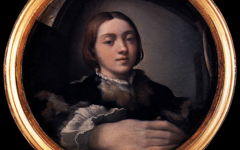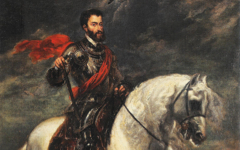Titian’s Pieta (c.1575)
Titian's Pietà, a late masterpiece intended for his own tomb, is a mysterious composition. On the right Titian himself as the "artist" Nicodemus crawls on his knees to "touch" and thereby "paint" Christ's body.1 We know Christ's body is a "work of art" because Christ's figure is itself based on a famous work of art, Michelangelo's own Pietà in the Vatican. In addition, Titian's beard overlaps Christ's arm, its hairs recalling the hairs of a paintbrush.2
Click next thumbnail to continue

Top: Detail of Titian's Noli Me Tangere (1511-12)
Bottom: Detail of Titian's Pietà (c.1575)
Click image to enlarge.
The gesture of "touch" to symbolize "painting" appeared decades earlier in Titian's Noli Me Tangere (top) in which Mary Magdalene as the "artist" is in a similar pose. There the resurrected Christ specifically said "Do not touch me" ("Noli Me Tangere") though Titian's Mary Magdalene was not listening; "she" painted him anyway. Her hand can be seen "touching" the "canvas" around Christ.
Click next thumbnail to continue

Left: Detail of Titian's Pietà (c.1575)
Right: Detail of Titian's Bacchus and Ariadne (1523-4)
Click image to enlarge.
Another feature of the Pietà is the novel figure of Mary Magdalene (far left), off to one side calling for help. She recalls the figure of Ariadne (near left), likewise off to the left side of Titian's Bacchus and Ariadne. I have already shown how Ariadne is the "artist" standing to one side of the "painting" holding up a hand "to paint." Mary Magdalene must be too.
Click next thumbnail to continue
In the Pietà Mary Magdalene is a second artist, a representation of the real Titian painting the canvas. The other Titian is inside the "canvas" as Nicodemus. Titian had long identified with Mary Magdalene in both his art and his letters.
Now imagine that the whole canvas is a mirror, a mirror of the artist's mind; Mary Magdalene becomes the reflection of the artist actively "painting" the scene, facing into it and not away from it.3
This discovery that Titian's late masterpiece is a "mirror" recalls another of our discoveries: that Velazquez's late masterpiece, Las Meninas, is a giant mirror too. It's worth a look.
More Works by Titian
Notes:
1. Some writers argue that Titian's figure represents Joseph of Arimathea, another artist said in apocryphal accounts to have been present at the Entombment of Christ. Either way, Nicodemus or Joseph, the figure is an "artist".
2. In Titian's Assunta (1516-18) several of the disciples' beards are used in a similar way. See Titian's Assunta.
3. See other examples under the theme, Mirrors
Original Publication Date on EPPH: 30 Mar 2012. | Updated: 0. © Simon Abrahams. Articles on this site are the copyright of Simon Abrahams. To use copyrighted material in print or other media for purposes beyond 'fair use', you must obtain permission from the copyright owner. Websites may link to this page without permission (please do) but may not reproduce the material on their own site without crediting Simon Abrahams and EPPH.





